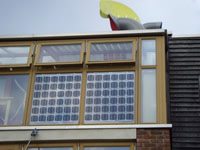 Polyera Corporation has achieve a certified world-record 9.1% efficient polymer/fullerene organic solar cellin an inverted bulk heterojunction architecture using its newest proprietary ActivInkR PV2000 semiconductor material.
Polyera Corporation has achieve a certified world-record 9.1% efficient polymer/fullerene organic solar cellin an inverted bulk heterojunction architecture using its newest proprietary ActivInkR PV2000 semiconductor material.
The high efficiency of this material in an inverted architecture, in combination with its other leading-edge properties, represents a substantial breakthrough in the development of organic solar cell technology for large-scale manufacturing of low-cost, lightweight, flexible, and optically semi-transparent solar modules.
The device performance was certified by Newport Corporation’s PV Cell Lab.
Solar power is gradually becoming cost-competitive with traditional mainstream energy sources such as oil and coal, but to achieve this still requires significant further reductions in the costs of materials, manufacturing, and installation.
Organic solar cells hold the promise of addressing these issues due to their potential to be manufactured on large areas at high speeds on lightweight substrates like plastic, but still require further increases in efficiency and operational lifetime to be truly most-competitive with traditional energy sources.
However, in the short term, other properties unique to organic solar cells – such as the ability to be light, flexible, and optically semi-transparent – make them perfectly suited for use in architectural or other design areas, such as windows that also act as solar panels, for use in office buildings or cars, where other energy technologies are infeasible. The key challenge, then, is enabling efficient enough organic solar technology that can also be cost-effectively and reliably manufactured at industrial scale.
The latest results from Polyera represent a significant step in that direction, demonstrating 9.1% power-conversion efficiency (i.e. how much energy from the sun is converted into usable electricity) combined with other very important – but often overlooked – factors that affect a technology’s true commercial viability. Inverted cell architecture, for example, provides a number of commercially-relevant benefits, such as making solar panels easier to manufacture and improving their useful life.
Polyera’s active layer materials can also be deposited using a significantly broader range of film thicknesses without lowering cell efficiency; this broader process window improves yields and further simplifies manufacturing. Polyera’s materials can also be processed at low enough temperatures to be compatible with a wide range of simple printing processes and common, inexpensive plastic substrates like PET or PEN.
Polyera will be launching a series of organic solar cell active-layer inks, to be commercialized under the trade name ActivInkR PV.
[quote_box_center]”We have concentrated our [solar] work on the chemistry of these materials and found a new way to design and combine the active layer building blocks to maximize certain optical and electrical properties”, says Antonio Facchetti, Founder & CTO of Polyera. “These latest results bring us a significant step closer to enabling true commercialization.”[/quote_box_center]
“It is broadly recognized that the availability of materials affording higher performance and lifetime is the key to unlocking the great potential of OPV technology and the past year has seen rapid advances on this front,” said Philippe Inagaki, Founder & CEO. “We are excited to further support the commercialization of OPV technology with our latest generation of ActivInkR PV materials.”